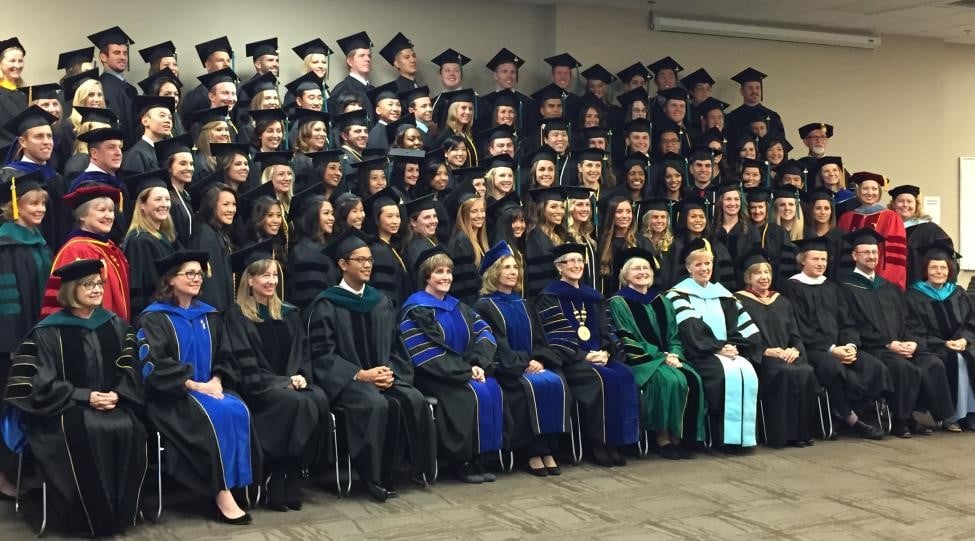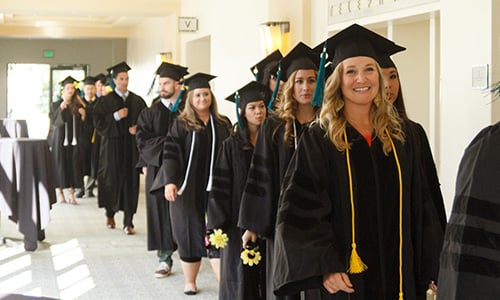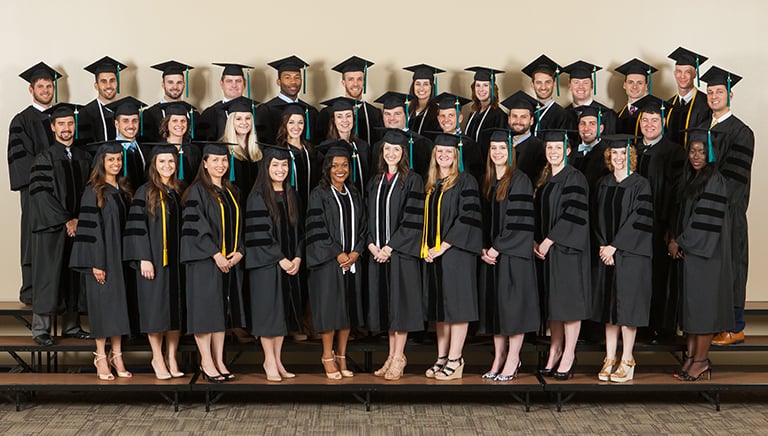
USAHS offers two premiere programs for the professional development of licensed physical therapists: the Clinical Orthopaedic Residency and the Orthopaedic Manual Physical Therapy Fellowship. Both programs are taught by experts in the physical therapy and educational fields and are directed by Amanda Grant, PT, DPT, OCS, MTC, CLT, FAAOMPT. Herself a graduate of the Fellowship program (in 2010), Dr. Grant is now a full-time program director, faculty member, and mentor to students. We spoke with her to learn more about these programs—what they are, how they are different, and how USAHS’ legacy ensures their outstanding quality.


Amanda Grant, PT, DPT, OCS, MTC, CLT, FAAOMPT
Director, Residency & Fellowship Programs
What Is the PT Residency?
A physical therapy residency is a hands-on mentorship program that enables students to specialize in a certain area, Dr. Grant explains. In the USAHS Clinical Orthopaedic Residency, the specialty is orthopaedics. The curriculum focuses on critical thinking, problem solving, clinical reasoning, and manual skills in the treatment of common conditions of the spine and extremities. It includes a minimum of 1,030 patient care hours, plus 160 hours of one-on-one mentorship. Students can take 12 months to complete the program, but may take up to 36 months.*
The Residency’s didactic learning is conducted primarily online, with asynchronous and synchronous aspects; students also participate in virtual journal clubs and case rounds. The mentorship aspect of the program is typically hands-on. Students come to our St. Augustine, Florida, campus three times throughout the program for end-of-term immersions, and they may also come to campus for up to a week at a time of intensive mentoring as they treat faculty, staff, and students. On-campus experiences were paused during the pandemic but are expected to resume with the Fall trimester.
The mentorship is a main benefit of the Residency, Dr. Grant says. “Instead of trial and error, you have someone to guide you through challenging times. Whereas clinical instructors are your superiors, and new employers might just be available to chat in the hallway and answer quick questions, in the Residency you have colleagues and mentors who challenge you to understand why you are choosing your examination tools and interventions. They provide one-on-one mentorship to help you troubleshoot more complex patient cases. The Residency helps you become the best evidence-informed practitioner you can be.”
The Residency is designed for recent graduates of Doctor of Physical Therapy programs, newer clinicians, and PTs changing specialty areas. It’s for those who wish to sit for the American Physical Therapy Association (APTA) specialist exam in orthopedics, which students can do upon successful completion of the program. According to Dr. Grant, completing a residency shortens the number of clinical hours needed to sit for this exam from 2,000 to 1,030.
USAHS Residency graduates have gone on to become residency mentors, clinical instructors, and private practice owners, and several have continued their training in Fellowship programs.
What Is the PT Fellowship?
The Orthopaedic Manual Physical Therapy Fellowship is designed for PTs who are already specialists in orthopaedics and who want to earn a subspecialty in manual therapy. Our founder, Stanley Paris, PT, PhD, is a renowned advocate of manual PT techniques, and USAHS has been a leader in this area of the field since our founding in 1979.
The Fellowship curriculum focuses on advanced training in orthopaedic manual physical therapy, including examination, evaluation, clinical reasoning, treatment, and patient management. “In the Fellowship, we often see more complicated cases that require thinking outside the box,” Dr. Grant says. “The mentors do a tremendous job of helping students develop a critical thinking framework, so they can reason through the process and discuss what hasn’t been tried yet.” Upon successful completion of the program, students become fellows of the American Academy of Orthopaedic Manual Physical Therapists (AAOMPT).
The structure is similar to the Residency program, with online didactic learning, 850 patient care hours, and 160 hours of one-on-one hands-on mentorship. Fellows-in-training attend seminars and take the Manual Therapy Certification through our Continuing Professional Education program. Like the residents, they also may travel to the St. Augustine campus for a week of intensive mentoring, expected to resume this fall. Students can take 12 months to complete the program, with a maximum of 36 months.*
How Does the Mentorship Aspect Work?
“It’s one thing to take all these courses, and another to be mentored,” Dr. Grant says. “Our mentors are some of the giants in the PT world. They’ve had many years to hone their craft and clinical mentoring skills.” Mentors identify strengths and weakness of the residents and fellows-in-training, and then provide the scaffolding to facilitate growth and expertise in their respective specialty areas.
In both programs, the mentorship is designed to be hands-on, though it can be a blend of in-person mentoring, virtual mentoring, or a hybrid of both. USAHS has clinical affiliations and mentors across the country, and we can add sites and mentors who meet our requirements—so students may be able to work with a trusted colleague at their workplace. USAHS faculty members also serve as mentors who can give feedback virtually or travel to the student’s site. Each student can have multiple mentors with different areas of expertise. “For other programs that are 100% in person, you have to uproot and move,” Dr. Grant says. “Ours are designed for flexibility and independence and for clinicians who want to integrate a structured program into an already busy life.”
Dr. Grant predicts that the demand for hands-on mentorship will increase in the wake of the COVID-19 pandemic. “Due to the increase in entry-level DPT virtual learning and telehealth services, we are anticipating that students and clinicians will be eager to participate in live mentorship opportunities to enhance their problem-solving and clinical skills,” she says.
What Sets USAHS Apart?
“We’re well known because of the people associated with our programs, the positive patient outcomes, the impact our graduates have had on the physical therapy profession, and the great things they’re doing,” Dr. Grant says. “It’s a humongous and awesome legacy of who we are.” Some key players:
- These programs were launched by Dr. Paris, founder of USAHS, first president of the Orthopaedic Section of APTA, and founding member of the AAOMPT. He is now retired from the University.
- Catherine Patla, PT, DHSc, MS, OCS, MTC, FAAOMPT, helped to found these programs and has been a principal faculty member in our PT department since 1979.
- Elaine Lonnemann, PT, DPT, OCS, MTC, FAAOMPT, is a graduate of USAHS, Associate Dean of USAHS’ College of Health Sciences, director of the Transitional Doctor of Physical Therapy program, and current President of AAOMPT.
- Ken Olsen, PT, DHSc, OCS, FAAOMPT, author of the textbook Manual Physical Therapy of the Spine, was among the first graduates of the Fellowship program and is a past president of AAOMPT.
Another USAHS differentiator is that “our programs are completely portable,” Dr. Grant says. “You don’t have to come every weekend for hands-on work.” And, she says, USAHS offers Manual Therapy Certification as part of its continuing professional education program.
She adds that USAHS’ teaching centers around a strong foundation in anatomy and biomechanics. “If you understand normal, you can see abnormal,” she says. “You must dig to find the root cause of tissue-specific impairments—not just treat the symptoms. If you have pain in the foot, it could be coming from anywhere along the kinetic chain. It is important to be thorough in your examination and always examine above and below the site of pain. While anatomy and biomechanical knowledge is a foundational principle in all PT education, we teach our residents and fellows-in-training how to systematically and confidently critically think and problem-solve through challenging cases.”
*Time to completion may vary by student, depending on individual progress, credits transferred, and other factors.








